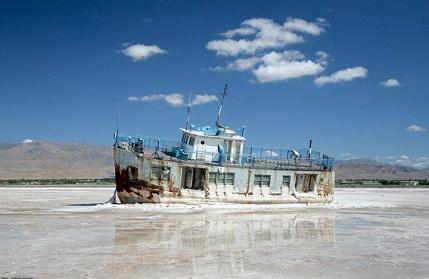 Larus armenicus
Larus armenicus
(last update:
3cy armenicus: May Larus armenicus in Iran - tragedy in Lake Urmia One of the main breeding sites for Armenian Gull worldwide is the Lake Urmia, situated in the NW corner of Iran. Annual surveys and monitoring actions about exact breeding numbers are not available, but it may still hold the largest breeding colony for Larus armenicus. Over the last decades, Lake Urmia is obviously facing large problems with decreasing water levels. Save Lake Urmia Campaign (www.saveurmia.com) is a group that likes to raise awareness of Lake Urmia and demand the international organizations such as UNESCO and FAO, and the Iranian government to take immediate actions to preserve the lake. The website provides much interesting background information, which is partly copied here below. LAKE URMIA: ECOLOGICAL DISASTERSource: Campaign to Save Lake Urmia In a recent DROUGHT of the Urmia basin, which started in 1999, the water level of Lake Urmia dropped from 1278 m to 1273 m above sealevel. Investigations show that water level will decrease further to 1270 m above sea level and water volume will decrease from 25 km3 to 11 km3 in a few years. Dropping water level is increasing the salinity. The lake salinity increased from 140 ppt to about 310 over the last decade. The possible causes of rising salinity are likely to be surface flow diversions, groundwater extractions and unsuitable climate condition. Similar to other saline lakes, Lake Urmia is particularly sensitive to environmental changes. HUMAN ACTIVITY and ineffective infrastructure management has worsened the situation. A project to construct a highway across Lake Urmia was initiated in 1979 to facilitate communication between Tabriz in East Azerbaijan and Urmia in West Azerbaijan. This highway divides the lake into south and north arms and significantly alters circulation of water. A research has concluded that over long-term periods, the causeway has not had a significant impact on the overall salinity patterns in the lake. However, full impact of this construction on ecosystem as well as decreasing water level has not been adequately investigated. More than 40 dams have been built over 13 rivers that feed the lake. Human population growth in the lake basin has seriously increased the need for agricultural and drinking water in recent years, all of which are supplied from surface and groundwater sources in the area. By holding back water, these dams result in an imminent decrease in freshwater inflow, a concomitant increase in salinity, and a decline in water level. In addition, driving deep water wells operated by electrical pumps, exporting water, and increasing population which require more water resources negatively affects the water level in the lake. If no action is taken, investigations show that surface water level will continue to decrease and water volume will continue to shrink. This will result in loss of flora and fauna around the lake described in the previous section. However, the scale of the ecological disaster will not end with lose of flora and fauna. Drying up the lake will release almost 8 BILLION TON OF SALTS IN THE AREA. The huge amounts of released salt will be blown away by the prevailing winds and will create ecological disaster in the region. More than 5 MILLION PEOPLE living around the lake will be affected by the scale of the disaster. SIMILAR DISASTER HAS ALREADY HAPPENED IN CENTRAL ASIA. The decision by the Soviet Government in 1918 to divert Amu Darya and Syr Darya to irrigate the desert for agricultural production, resulted in a complete lose of Aral Lake – one of the largest lakes in the world. Flora and fauna surrounding the lake has been devastated by high salinity and communities residing around the lake are experiencing worst environmental conditions. The lost of Aral Lake is considered “one of the planet’s worst environmental disasters”. According to leading ecologists and Iranian officials, if Lake Urmia dries up an ecological catastrophe is inevitable not only in Azerbaijani cities of Iran but also, in neighboring countries of Iraq, Turkey, Azerbaijan, and Armenia. It could trigger a colossal migration of those living around the lake. Consequences of drying:
INCREASED SALINITY IN THE AREAS IS ALREADY AFFECTING THE AGRICULTURE There has been a thriving agricultural community along Lake Urmia. There are 9 cities adjacent to the lake, where agriculture is the main part of the economy and the major source of income for the communities. However, increased levels of salt toxicity in the area is damaging agricultural production. RESEARCH RELATED TO LAKE URMIA:
|
 Larus armenicus 3cy May 14 2010 Eilat, Israel. Picture: Amir Ben Dov. Larus armenicus 3cy May 14 2010 Eilat, Israel. Picture: Amir Ben Dov.
|

